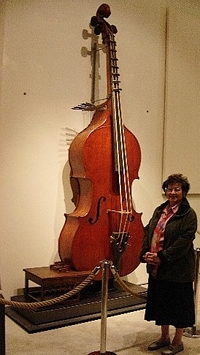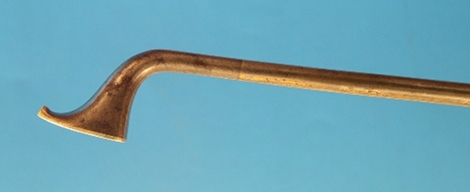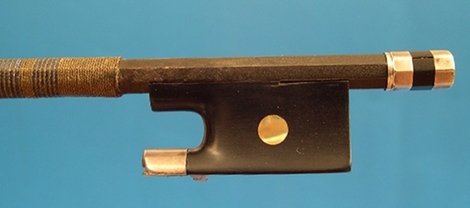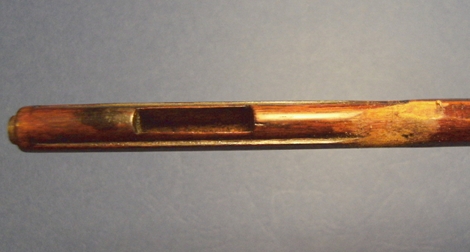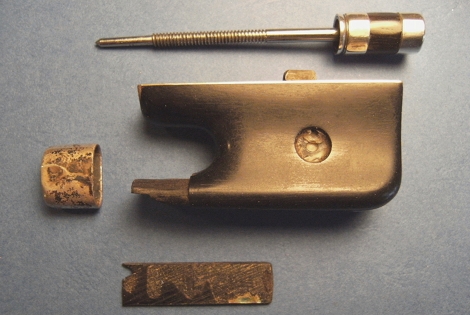VUILLAUME THE INNOVATORThe instrument depicted in the photo is 3.85 meters high, you change the notes by pressing a button panel located on the upper right side of the instrument, while to pull the bow you have to climb on the stool placed at its base. Whoelse but Vuillaume's could have ever thought of a such a Pachyderm-sized instrument ? The Octobass, was built by Vuillaume in close cooperation with Hector Berlioz, and despite he himself spoke enthusiastically about it in his famous treatise of instrumentation, because of the evident complexity, never had a specific use, but it says a lot about the imagination, inventiveness and tenacity of its builder. As mentioned last week, Vuillaume's character is difficult to depict and, before starting to talk about the technical innovations he introduced, it is necessary trying to understand something more about his character. Jean Baptiste Vuillaume was first of all a merchant of a very special breed. The best bows and instruments were either manufactured or traded by him and this allowed him to have among its customers some of the best musicians of the time. But being a tradesman, he was aware of the importance about selling to both small and big buyers and for this reason most of his life was devoted to try new and practical solutions so to offer them to customers that might be less educated but wider. One of his queerest inventions, surpassed only by the Octobass (maybe) is the Ironbow, i.e. a bow made of iron. If seen today it can induce to a smile, but of this particular bow model built by craftsmen outside the laboratory, Vuillaume was able to place 5560 pieces from 1834 to 1850. The musicians needed more than fifteen years to realize that steel is not playing, nevertheless he made an excellent investment! Steel bow J.B. Vuillaume One of the most famous and discussed innovation was certainly the self-rehairing bow, trying to solve the problem of hair change for those who did not live in a big city or for those musicians who were always on tour. The bow and an illustrated user's book was supplied with a few bunches of hair wrapped up in a metal cylinder that held it in place and combed at the two edges. The head had a circular hole across slightly above the foot, near the mortise, in which the cylinder with horsehair was inserted. As far as the frog is concerned , things were a bit more complicated. The slide was glued to the top of the frog and the housing for the cylinder with horsehair was welded to the nut. In this way even if the hair was not perfectly combed , you could stretch them by simply turning the screw. This solution was a huge success thanks to the far from little problems it was going to solve, but caused more than a bad mood. It seems that during the same period another craftsman, who is also fairly well known, Etienne Pajeot, was working on a similar project, but it not known how Vuillaume beat it on time and on 26 February 1836 his patent with an exclusivity for five years was accepted. This did not to please the dear Etienne at all , who indeed seems to have had the idea at first , and this definitely damaged an already hard relationship between the two of them . Another novelty he introduced was the support of the frog not with a noctagonal shape but a circular one, named in his honor, "Vuillaume" It consisted into making a circular break longitudinally at the octagon of the stick near the mortise. This operation served to create a guideway for the frog as well provided with the circular support . Now fallen into disuse, this type of support was conceived to achieve a more stable and perfect grip of the frog to the stick, but it was soon realized that the wear ould damage it very quickly, and that contrary to the other one, it was was very difficult to restore it. If you click on the images you can realize it. Restoration of a Vuillaume support , stick Restoration of a Vuillaume support , frog Apart frogs with weird shapes, such as a lion in ivory whose hair came out from his mouth, J.B.V. loved to surprise, and one of his best commercial thoughts was the frog with the micro-photos. Instead of the eyes of the frog, a lens and a glass to let light pass thru were inserted and in the middle of the frog, (thinking that it was done by the mid-nineteenth century is at least surprising) , was placed a thumbnail from 1 mm to 0.5 mm. Of course, in addition to the innovations he also made trade and advertising. He had his own rosin and not to leave any type of market untouched, he visited and looted the workshops in Mirecourt, as that one of his brother Nicolas in particular, bringing to the Paris cheap instruments and bows that he sold to young students and which today are often mistaken for original by non-experts (or intentional experts) thus overestimated ; so beware! The research carried out by Vuillaume throughout his life, even if it did not go entirely well, allowed him neverthelsss, as cited in Raffin's book (note: The Archet), to pave the way for those who have been the next Lamy and Sartory, allowing them to avoid the same mistakes, although if new ones were made, as unfortunately no one is exempt from them. So long Paolo.
|
   |






